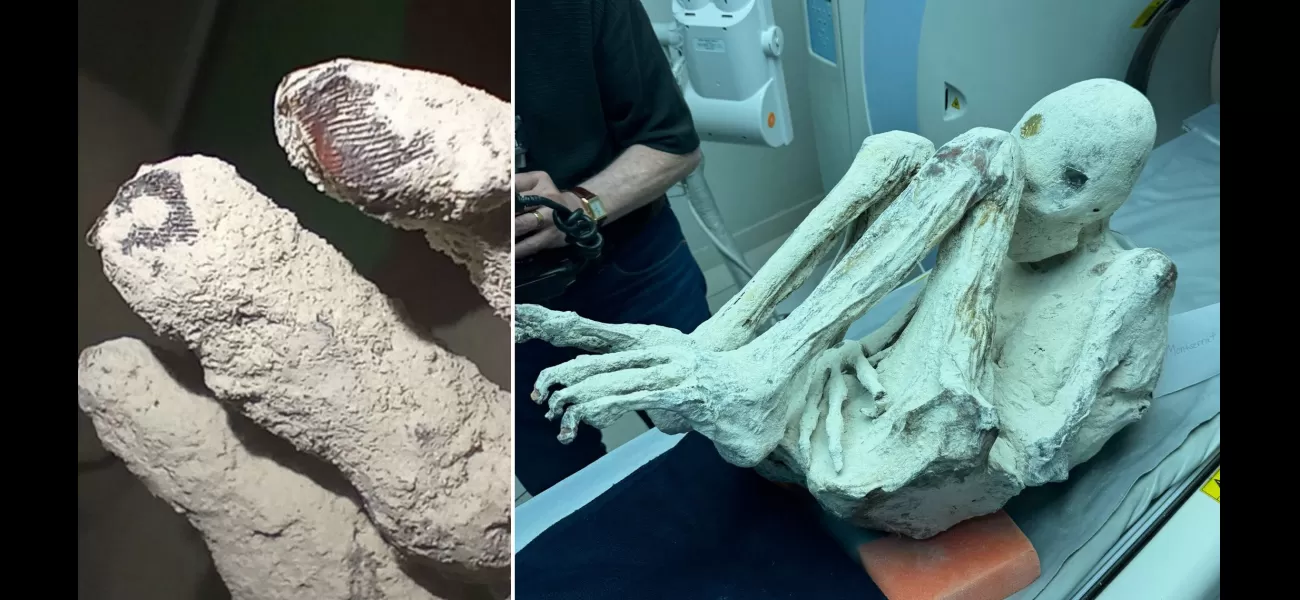Mummies discovered in Peru with non-human fingerprints.
María's prints didn't match those of a human being.
July 24th 2024.

As we examine the picture, we can't help but wonder about the alien's massive shoes, which are not visible in the image. It's quite intriguing to think about the size of those shoes, considering the being's humanoid appearance. Speaking of which, María is quite the sight to behold, with her chalky body and egg-shaped head. She has long, three-fingered hands and three-toed feet, which definitely emphasizes her humanoid features.
For UFO researchers, María is believed to be a mummified alien that was buried in southern Peru for over a thousand years. However, those who are more skeptical, such as scientists, government officials, and archaeologists, argue that she is simply a human mummy or perhaps a cleverly executed hoax. Despite the ongoing debate, one thing is for sure - the mystery surrounding María's identity only deepens as new evidence is uncovered.
When María was discovered in the remote Nazca region, she was found covered in a dusty substance known as diatomaceous earth, which is made up of fossilized plankton remains. Interestingly, her fingers and toes were visible, and upon closer inspection, Joshua McDowell, a former Colorado prosecutor, made a striking observation. He noticed that María's fingerprints were not typically human, which sparked even more curiosity and speculation.
McDowell then assembled a team of experts, including a Denver coroner, a forensic anthropologist, and his father, a forensic odontologist, to conduct a thorough analysis of the remains. However, their investigation is still ongoing, and they have yet to come to a definitive conclusion. María is one of six mummified three-fingered specimens, known as the Nazca tridactyls, that were discovered in Peru in 2017. These findings have baffled both ufologists and officials alike.
In 2019, two of these non-human beings, named Waita and Albert, were presented at an event at Peru's San Luis Gonzaga National University of Ica. The event was organized by Jaime Maussan, a well-known journalist who has been fascinated with aliens for many years. He also presented these specimens to Mexico's Congress last year. However, unlike María, these two beings had doll-like features with elongated bodies and shrunken or desiccated heads.
Maussan explained to the parliamentarians that researchers from the Institute of Physics at the National Autonomous University of Mexico had carbon-dated the remains and found them to be approximately 1,000 years old. However, the institution clarified that they had only tested skin samples provided by a client and had not directly examined the specimens themselves. Maussan also claimed that these beings, regardless of their origins, were intelligent and coexisted with humans, which could potentially rewrite history.
The question of how Maussan acquired these tridactyls remains unclear. It is also unknown if the ones he presented were authentic or reproductions, and if they were indeed genuine, how they were transported from Peru to Mexico. The Peruvian Attorney General's Office conducted an analysis of the remains and concluded that they were recently manufactured using human and animal bones, vegetable fibers, and synthetic glue. Additionally, one of the smaller specimens was found to have a broken llama braincase, a common animal in the region.
In January of this year, the same remains that Maussan presented to the Mexican Congress were detained by Peruvian customs. The government's forensic experts dismissed them as mere dolls, which echoes the criticisms surrounding the mummies' authenticity. Many believe that these mummies were manipulated to give them a resemblance to the stereotypical "grey" aliens.
Despite the skepticism and criticism, Maussan remains adamant that these beings are genuine and that their origins are extraterrestrial. In March, he claimed that cracking the mystery of the Nazca aliens would not be an easy feat. The Peruvian government has stated that they can only analyze human DNA, which has posed a challenge in determining the true nature of these specimens. However, Maussan recently shared a statement from 10 scientists from the National University of Ica, who concluded that the DNA of these beings is 29% "of origin that does not belong to the evolutionary chain of the Earth." More testing is needed due to the unknown nature of these organisms, but it appears that the mystery of the Nazca aliens is far from being solved.
For UFO researchers, María is believed to be a mummified alien that was buried in southern Peru for over a thousand years. However, those who are more skeptical, such as scientists, government officials, and archaeologists, argue that she is simply a human mummy or perhaps a cleverly executed hoax. Despite the ongoing debate, one thing is for sure - the mystery surrounding María's identity only deepens as new evidence is uncovered.
When María was discovered in the remote Nazca region, she was found covered in a dusty substance known as diatomaceous earth, which is made up of fossilized plankton remains. Interestingly, her fingers and toes were visible, and upon closer inspection, Joshua McDowell, a former Colorado prosecutor, made a striking observation. He noticed that María's fingerprints were not typically human, which sparked even more curiosity and speculation.
McDowell then assembled a team of experts, including a Denver coroner, a forensic anthropologist, and his father, a forensic odontologist, to conduct a thorough analysis of the remains. However, their investigation is still ongoing, and they have yet to come to a definitive conclusion. María is one of six mummified three-fingered specimens, known as the Nazca tridactyls, that were discovered in Peru in 2017. These findings have baffled both ufologists and officials alike.
In 2019, two of these non-human beings, named Waita and Albert, were presented at an event at Peru's San Luis Gonzaga National University of Ica. The event was organized by Jaime Maussan, a well-known journalist who has been fascinated with aliens for many years. He also presented these specimens to Mexico's Congress last year. However, unlike María, these two beings had doll-like features with elongated bodies and shrunken or desiccated heads.
Maussan explained to the parliamentarians that researchers from the Institute of Physics at the National Autonomous University of Mexico had carbon-dated the remains and found them to be approximately 1,000 years old. However, the institution clarified that they had only tested skin samples provided by a client and had not directly examined the specimens themselves. Maussan also claimed that these beings, regardless of their origins, were intelligent and coexisted with humans, which could potentially rewrite history.
The question of how Maussan acquired these tridactyls remains unclear. It is also unknown if the ones he presented were authentic or reproductions, and if they were indeed genuine, how they were transported from Peru to Mexico. The Peruvian Attorney General's Office conducted an analysis of the remains and concluded that they were recently manufactured using human and animal bones, vegetable fibers, and synthetic glue. Additionally, one of the smaller specimens was found to have a broken llama braincase, a common animal in the region.
In January of this year, the same remains that Maussan presented to the Mexican Congress were detained by Peruvian customs. The government's forensic experts dismissed them as mere dolls, which echoes the criticisms surrounding the mummies' authenticity. Many believe that these mummies were manipulated to give them a resemblance to the stereotypical "grey" aliens.
Despite the skepticism and criticism, Maussan remains adamant that these beings are genuine and that their origins are extraterrestrial. In March, he claimed that cracking the mystery of the Nazca aliens would not be an easy feat. The Peruvian government has stated that they can only analyze human DNA, which has posed a challenge in determining the true nature of these specimens. However, Maussan recently shared a statement from 10 scientists from the National University of Ica, who concluded that the DNA of these beings is 29% "of origin that does not belong to the evolutionary chain of the Earth." More testing is needed due to the unknown nature of these organisms, but it appears that the mystery of the Nazca aliens is far from being solved.
[This article has been trending online recently and has been generated with AI. Your feed is customized.]
[Generative AI is experimental.]
0
0
Submit Comment





